|
TITANIC
OCEANGATE EXPEDITIONS
ATLANTIS
STORY
MAP &
OPERATION HOMEPAGE
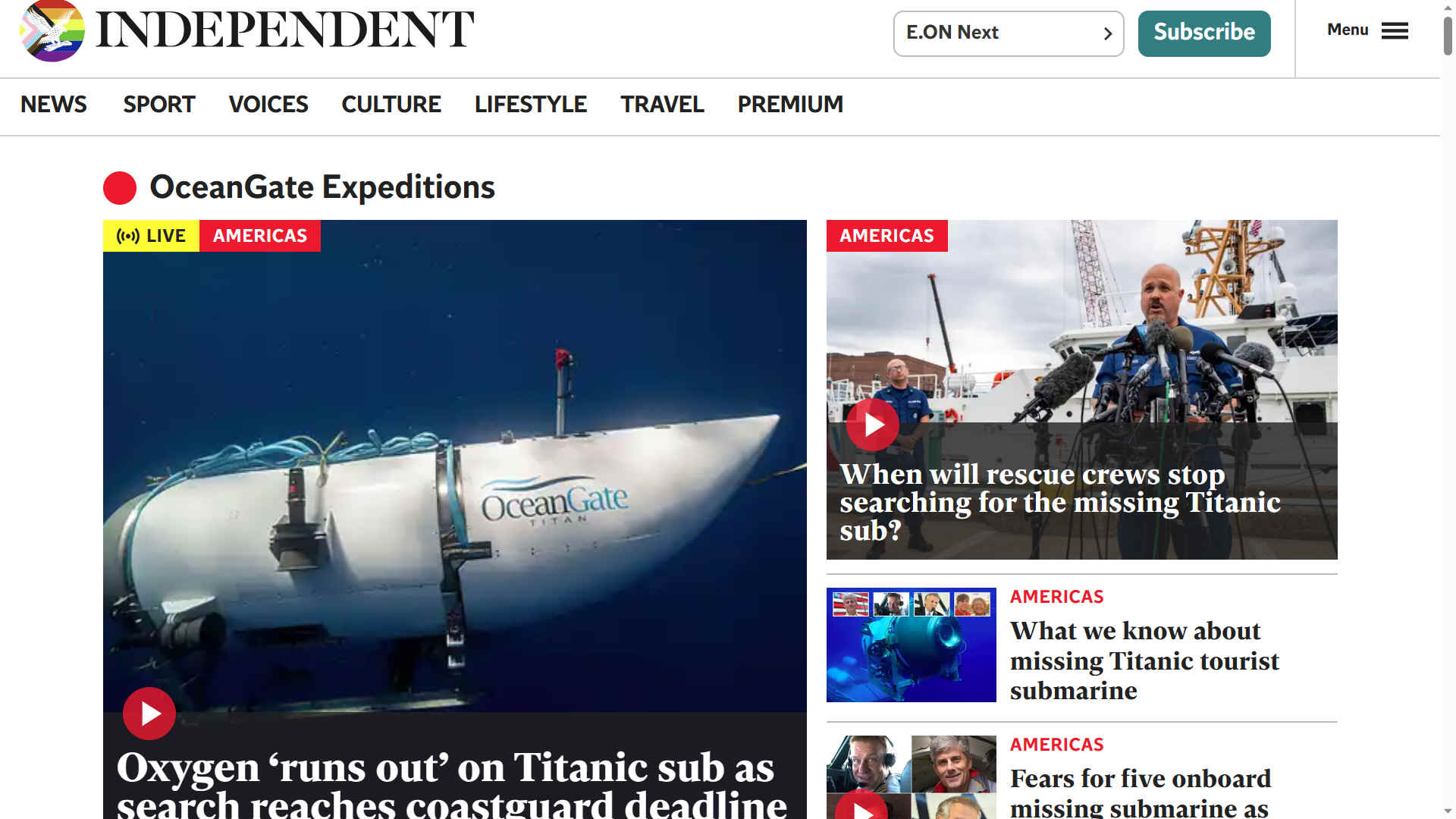
QUESTIONS
NEED ANSWERING - Where it is confirmed that the famous five
occupants are lost to the sea, it is in the interests of all
deep sea mariners to know what went wrong. The design looks to
be sound enough, but clearly something went tragically wrong.
And we need to know what that may have been, especially for
the friends and family of those brave souls.
DAILY MAIL 11 JULY 2023 - TITANIC SUB VICTIMS AWARE OF FATE
FOR A MINUTE BEFORE IMPLOSION
-
A submarine expert said the Titan fell 'like an arrow' due to a power failure
-
For a minute its passengers would have descended in total darkness, he says
-
That rapid change of pressure would have caused the catastrophic implosion

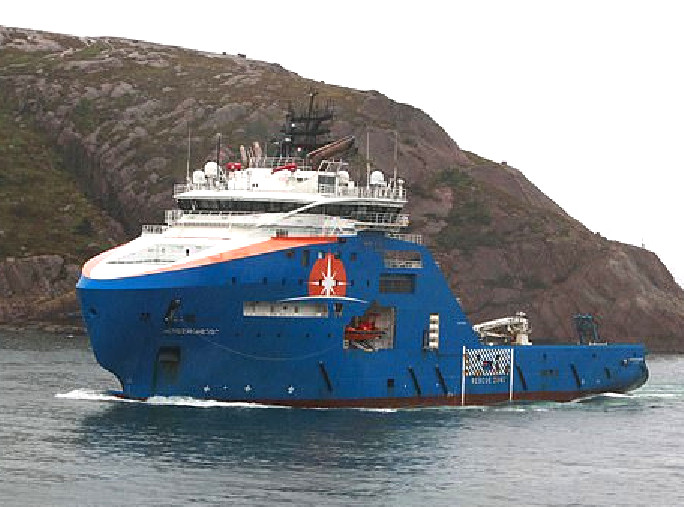
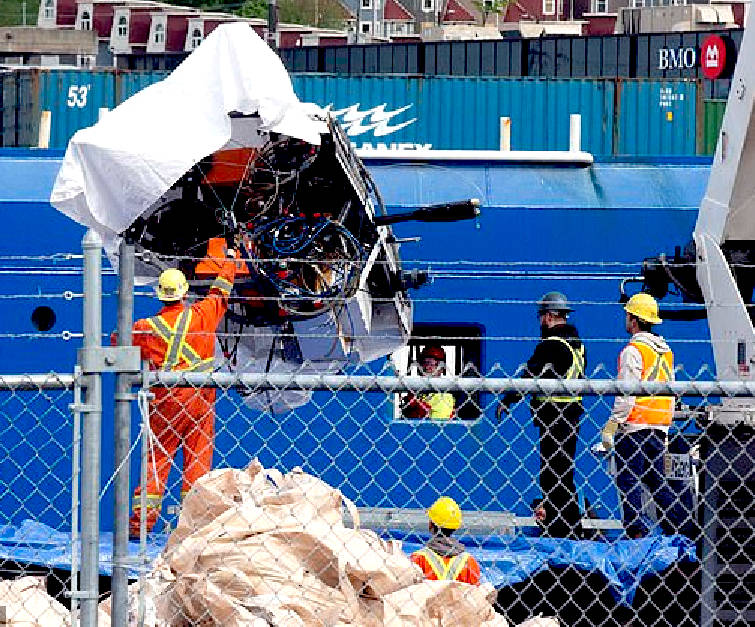
The passengers that died on the Titan submersible would have been aware of the impending catastrophe for a minute before the implosion, an expert has said.
Spanish submarine expert José Luis Martín suggested the submersible lost stability due to an electrical failure that left it without propulsion, causing it to fall toward the seabed 'like an arrow vertically' with its porthole facing down.
He estimated that the sub began freefalling at a depth of around 5,600 feet and fell 'as if it were a stone and without any control' for about 3,000 feet until at around 8,600 feet it 'popped like a balloon' due to the rapidly changing pressure.
Martin suggested the passengers would have been piled on top of each other in terrifying total darkness throughout the fall, which would have lasted between 48 and 71 seconds.
The Titan submersible lost communications with its support vessel on Sunday, June 18, during a descent to the wreck of the Titanic 12,500 feet beneath the surface.
Days later, its debris was recovered. It was said to have suffered a 'catastrophic implosion'.
Tourists Hamish Harding, 58, Shahzada Dawood, 48, and his son Sulaiman Dawood, 19, French Navy pilot Paul-Henry (PH) Nargeolet and OceanGate CEO Stockton Rush all died on the submersible.
Martin offered his theory as to how the submersible failed during an interview with Spanish newspaper Nius.
'The starting point is that the submarine is descending without any incident and in a horizontal plane until it reached about 1,700 meters (5,500 feet).
'At that point, there was an electrical failure. It was left without an engine and without propulsion. That's when it lost communication with the Polar Prince,' he told the newspaper.
He then suggested that the lack of propulsion would have caused it to lose stability and begin descending rapidly.
'The Titan changed position and fell like an arrow vertically, because the 400 kilos of passengers that were in the porthole compromised the submarine. They all rushed and crowded on top of each other,' Martín added.
'Imagine the horror, the fear and the agony. It must have been like a horror movie.'
Due to the depth and the lack of both natural light and electricity, the group would have been in total darkness as they sank toward the bottom of the Atlantic, he said.
'In that period of time they are realizing everything. And what's more, in complete darkness. It's difficult to get an idea of what they experienced in those moments. After those 48 seconds, or one minute, the implosion and instantaneous sudden death occur,' he said.
Martin compared the implosion to 'puncturing a balloon' and said it was not caused by depth alone but the sudden increase in pressure as the sub descended like a dart.
The submersible lost contact with the mothership about 105 minutes into its dive and about 400 miles off the coast of Newfoundland in Canada.
The US Coast Guard confirmed the victims' deaths four days later and an investigation into the implosion is ongoing.
On June 18, the OceanGate sub was launched around 8am in the Atlantic Ocean above the site of the Titanic shipwreck.
The five passengers started to descend as Rush piloted the vessel. At 9:45am it lost contact with its mothership, the Polar Prince.
OceanGate Expeditions took eight hours to report the missing sub to the US Coast Guard after it lost contact.
That led to a massive international response to rescue the five passengers. Ships from across the globe started to make the trek to help search for the missing sub while the hours and estimated oxygen ticked down.
Days later, it was announced the five people aboard the sub were believed to have been killed in a likely implosion.
It was also revealed that a US Navy monitoring system picked up a possible sound of the implosion in the descent - but search efforts continued.
After announcing the death of the five passengers, it was later revealed that debris form the imploded sub was found near the site of the Titanic.
Canadian police are considering whether 'criminal, federal, or provincial laws' were broken in the lead up to the Titan submersible disaster.
The Royal Canadian Mounted Police are examining 'the circumstances that led to the deaths' of the five crew on board the sub and decide 'whether or not a full investigation is warranted'.
Their investigation started at the end of June, a day after it emerged human remains were found during the recovery mission and segments of the vessel were brought ashore.
Superintendent Kent Osmond, of the Royal Canadian Mounted Police, said a team of investigators has been established with the 'sole purpose' of determining whether a criminal investigation would be warranted.
'Such an investigation will proceed only if our examination of the circumstances indicate criminal, federal or provincial laws may possibly have been broken,' he said.
'Following the US Coast Guard's announcement earlier this week that debris from the submersible was located and all five on board were presumed dead, we will now look at the circumstances that led to those deaths.
'Our investigators are engaged and active in this matter as of this morning. Once a determination has been made as to whether or not a full investigation will be launched, we will provide an update at that time.'
Families of the Titan submersible victims could sue its operator OceanGate, the maker of the vessel and companies that provided parts, legal experts have said.
Lawyers said relatives could seek damages from any outside parties involved in the Titan's construction if they were found to be negligent and a cause of the implosion.
Experts say wrongful death and negligence lawsuits could be filed by families of the victims. The five passengers who died are thought to have been asked to sign liability waivers before they boarded the vessel.
The waiver said that passengers could experience physical injury, disability, emotional trauma and death while on board the Titan.
That waiver could play a big role in legal action as families consider their options, but a major complicating factor is that the disaster happened in international waters.
Legal experts say the implosion occurred 'basically in a regulatory no man's land' and jurisdiction will be hard to establish both for the families and the investigations.
Any disputes relating to the waivers would likely be governed by the laws of the Bahamas, where OceanGate is registered – but families could also try to declare the waiver to be invalid in the US and bring a lawsuit there, or in their home countries.
US legal expert Dr. Nick Oberheiden, of Federal-lawyer.com, said families could win more than $100million if they sue OceanGate - and could choose to pursue it as a group claim, which might improve their chances of winning by sharing resources.
A CBS reporter who made the trip with OceanGate Expeditions in July 2022 reported that the waiver he signed mentioned the possibility of death three times on the first page alone.
Legal experts said what the investigation into the disaster uncovers will determine much about any legal case from families, including what caused the vessel to implode.
Liability waivers - sometimes referred to as release forms - are typical before doing recreational activities that carry some measure of risk, such as sky diving or scuba diving.
By signing the document, passengers generally accept the risk and dangers related to the activity and if they are injured, absolve the company's owner of liability.
Matthew Shaffer, a trial lawyer with the maritime personal injury law firm Schechter, Shaffer and Harris, said the forms are commonplace before doing any kind of 'ultra-hazardous recreational activity.'
'A good release will cover any and all potential harm and you are going to spell it out in simple language as possible,' he said.
At least 46 people successfully travelled on OceanGate's submersible to the Titanic wreck site in 2021 and 2022, according to letters the company filed with a US District Court in Norfolk, Virginia, that oversees matters involving the Titanic shipwreck.
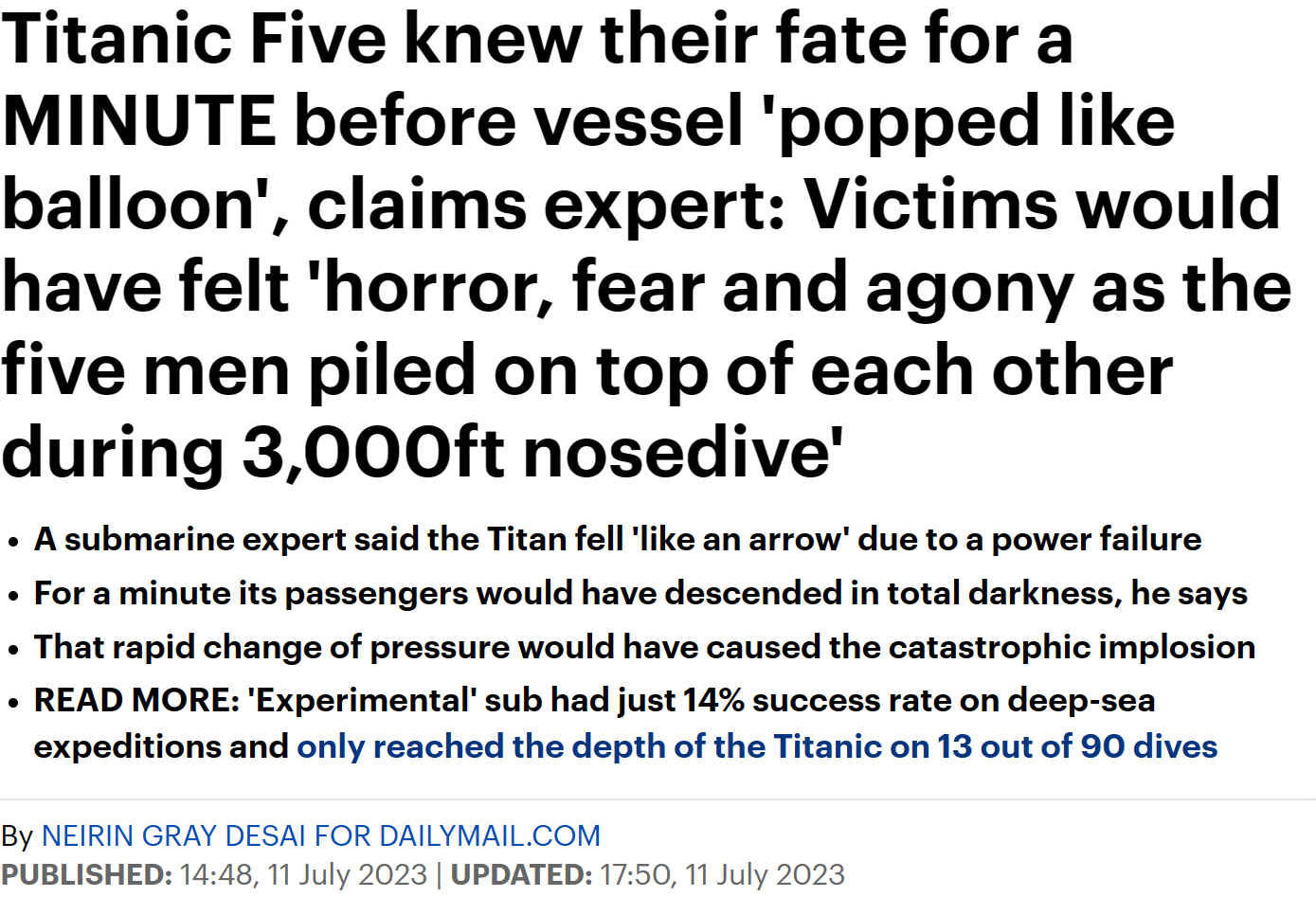
THE MIRROR 29 JUNE 2023 - TITANIC SUBMARINE'S 'CRITICAL CRACK' AND 'ELECTRICAL CATASTROPHE' BEFORE IMPLODING
The submarine-like vessel that imploded at the bottom of the Atlantic while on a mission to view the Titanic shipwreck had a "critical crack" and "electrical failure", an expert has said.
He has revealed why he thinks the sub, named Titan, had a catastrophic failure which claimed the lives of five earlier this month.
Dr Graham-Jones, Associate Professor in Mechanical and Marine Engineering at the
University of
Plymouth, said that parts of the vessel could have begun to leak which may have caused an electrical disaster.
He said: "This could have been an electrical catastrophe. It could have been corrosion, it could have been a fire. Any leakage of water coming through to the electrics could lead to failure as well."
He added to the Sun: "Some of the pipes and parts that lead outside could have begun to leak. If you have a wire going outside, then those wires going through land could actually start to leak. They could have corroded."
Although he cautioned that if there was a very minor leak, the passengers may have been aware of it and the most likely case was an instant implosion.
Dr Graham-Jones said he could see casings for piping and electrical wiring, but now they have seized the wreckage they can signify what exactly went wrong with the patterns of the cracks.
He said: "The crack could be brittle, or ductile, and related to fatigue and de-lamination. By scanning under an electron microscope, you can see the fatigue and confirm the speed and direction of the cracks."
Today, human remains were likely recovered from the wreckage of the submersible following collection of the wreckage from the seafloor more than 3,658 meters below the surface of the sea.
Stockton Rush, the Titan's pilot and CEO of OceanGate Expeditions, the company that owned the submersible, was killed in the implosion along with two members of a prominent British-based Pakistani family, Shahzada Dawood and his son Suleman Dawood; British adventurer Hamish Harding; and Titanic expert Paul-Henri Nargeolet.
The Transportation Safety Board of Canada, which is conducting a safety investigation into the Titan's mothership, the Polar Prince, said Wednesday that it has sent that vessel’s voyage data recorder to a lab for analysis.
Authorities have not disclosed details of the debris recovery, which could have followed several approaches, according to Carl Hartsfield, who directs a lab at the Woods Hole Oceanographic Institution that designs and operates autonomous underwater vehicles and has been serving as a consultant to the Coast Guard.
“If the pieces are small, you can collect them together and put them in a basket or some kind of collection device," Hartsfield said.
He explained that bigger pieces could be retrieved with a remote-operated vehicle, such as the one brought to the wreckage site by the Canadian ship Horizon Arctic to search the ocean floor.
For extremely big pieces, a heavy lift could be used to pull them up with a tow line, he said.
By Rachel Hagan
DAILY MIRROR 29 JUNE 2023 - WHY ARE TITAN SUB REMAINS SO BIG? EXPERTS WEIGH IN AS QUESTIONS FLY ABOUT 'VAPORISED' WRECK
Large parts of the Titan tourist submersible have been recovered from the ocean after a fatal implosion that instantly killed three Brits on board.
British adventurer Hamish Harding and father and son Shahzada and Suleman Dawood were killed inside the deep-sea vessel, alongside OceanGate Expeditions' chief executive, Stockton Rush, and French national Paul-Henri Nargeolet.
They were set to explore the famous Titanic wreckage located 12,500 feet beneath the ocean, but now presumed human remains have been discovered, the US Coast Guard revealed on Wednesday night.
Photos have since emerged of large chunks of debris being retrieved and transported to shore in St John's, Newfoundland, Canada, sparking questions about how such big pieces could survive an implosion of such magnitude.
The pieces included a large, white section of curved metal appearing to show the outer casing of the 21-ft Titan sub. Another piece showed cables, onboard computers and other mechanical parts.
A large circular part of the Titan, which appeared to be the dome-shaped front section, was also found.
But it has left many questioning how such large pieces of the sub were discovered when the explorers on board experienced a 'catastrophic implosion'.
Experts previously told NBC News that the water pressure on the sub would have been the equivalent of the 10,000-ton, wrought-iron Eiffel Tower.
The force of the implosion, it was said, would have been so strong that the craft's carbon-fibre hull would have just 'suddenly vanished', vaporising and killing all inside before they knew anything was wrong.
So why are there any remains to recover in the first place?
A coastguard source from St John's, where the ill-fated adventurers set off on June 17, told the Mirror the debris will now be pieced back together to help with ongoing investigations - including the UK Marine Accident Investigation Branch that has been brought in to probe the tourist deaths.
And this could be made easier due to the size of the craft's remains, according to an expert.
The submersible's construction included at least one titanium end cap, a titanium ring and a carbon fibre cylinder.
OceanGate had been previously warned by ex-staff members of the safety of the submersible after it was revealed its carbon fibre hull, which housed the five passengers, was its "Achilles heel" - because the material is not considered suitable for deep dives.
Tom Maddox, CEO at Underwater Investigators, said investigators were expecting the Titan to have been blown to pieces.
"Many of us suspected that, in the case of this catastrophic failure, this implosion, that a lot of the parts would be disintegrated, particularly the non-titanium parts, which, of course, would make the investigation a lot harder to do," he told DailyMail.com.
Although finding larger remains means investigators will have "more pieces of the puzzle to put together".
"They'll put it back as best they can," he said.
"I don't think there's a rulebook for this, you know, there's no manual, this is something new.
"And they're going to have to kind of write the book as they go along, would be my thought, but they'll use their past experiences and their knowledge to do that."
Meanwhile, Arun Bansil, university professor of physics at Northeastern, has explained a basic overview of the physics involved in the violent crash before explaining the reason why we are seeing such large pieces of debris.
"In an explosion, the force acts outwards, but in an implosion, the force acts inwards. When a submersible is deep in the ocean it experiences the force on its surface due to water pressure," he told Northeastern Global News.
"When this force becomes larger than the force hull can withstand, the vessel implodes violently.
"The key is the design of the hull that protects the vessel against the large external water pressure that is trying to crush the hull."
Professor Bansil says that most of the existing technology is based on steel, titanium and aluminium, with the performance of these materials under extreme stress being well understood.
He added: "However, the Titan's hull had an experimental design.
"It used mostly carbon fibres, which have the advantage of being lighter than titanium or steel, so Titan could have more space for passengers.
"Properties of carbon fibres for deep sea applications are, however, not that well understood. It can crack and break suddenly.
"Titan had previously gone for deep sea dives a few times, which would have contributed to the fatigue of the hull to make the hull more prone to catastrophic failure."
Speaking with the Mirror, the expert explained why we have seen large parts of the vessel remain intact.
"Although it seems counterintuitive, large objects do not normally split apart into smithereens in an implosion or explosion," Prof Bansil said.
"For example, a pressure cooker usually explodes with the top blown off but the body remains intact. The initial failure of Titan would have occurred at its weakest links such as defects in the hull.
"Once a crack opens, however, large pieces of the hull will no longer experience very violent forces and remain more or less intact."
At this stage, officials are not sure how soon into the dive the vessel imploded.

BRITISH
BILLIONAIRE - Hamish Harding was one of the five crew of the
fated OceanGate voyage to view the Titanic wreck.
The Titan submersible lost contact with tour operator OceanGate Expeditions an hour and 45 minutes into the two-hour descent to the wreckage, with the vessel reported missing eight hours after communication was lost.
Stockton Rush, CEO of OceanGate, previously explained in a haunting interview that "as you're descending, you've got your depth and altitude… that's pretty critical. When you get close to the bottom, you have to be ready to drop some weight so you don't go crashing into it, or thrust..
The billionaire, who has officially been declared deceased, continued: "So getting that notification 200 metres above the bottom is pretty critical. And then when we use our laser scanning system, we need correction data for through water speed currents and the light to keep the errors down, and that’s it, that’s the element of adding [coms] on the sub."
Pelagic Research Services – whose remote operating vehicle (ROV) discovered the debris fields – said on Wednesday its team is 'still on mission'.
In a statement, Captain Jason Neubauer, Chair of the Marine Board of Investigation said: "I am grateful for the coordinated international and interagency support to recover and preserve this vital evidence at extreme offshore distances and depths.
"The evidence will provide investigators from several international jurisdictions with critical insights into the cause of this tragedy.
"There is still a substantial amount of work to be done to understand the factors that led to the catastrophic loss of the Titan and help ensure a similar tragedy does not occur again."
In a statement last week, OceanGate said it was "an extremely sad time for our employees who are exhausted and grieving deeply over this loss".
By Saffron Otter
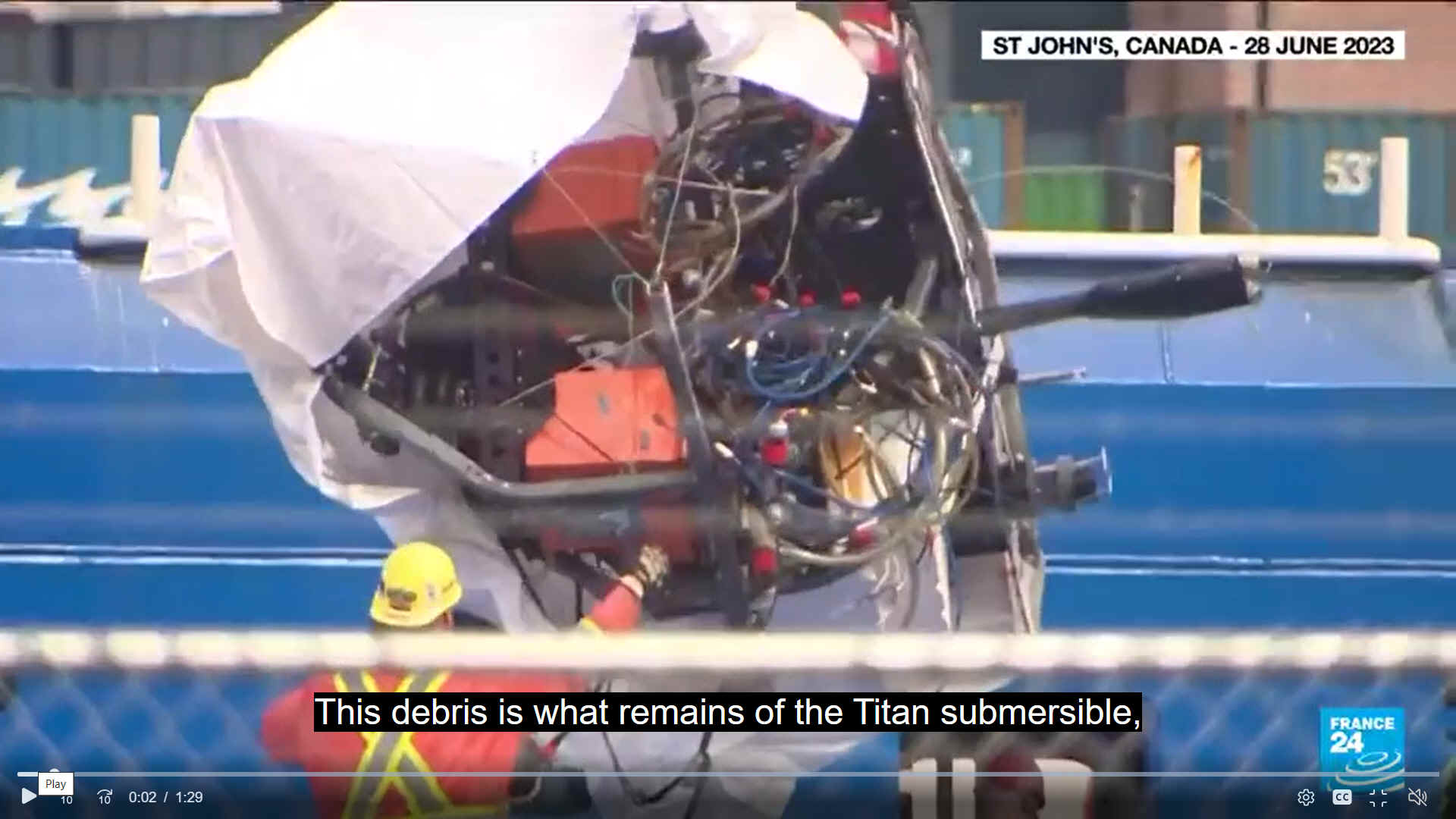
THE INDEPENDENT 27 JUNE 2023 - WHY WE ARE OBSESSED WITH THE MISSING 'TITAN' SUBMARINE, ACCORDING TO EXPERTS
The search for the missing Titan submersible fully captured the world’s attention, from reports of mysterious “banging” noises to estimates of how much oxygen may have been left in the underwater vessel.
On 18 June, the OceanGate Expeditions submersible Titan was beginning its trip to visit the Titanic wreckage at a depth of 12,500ft. About one hour and 45 minutes into its deep dive, the submersible lost communications with its surface ship, the Polar Prince, and was believed to have suffered a “catastrophic implosion”.
Aboard the Titan were CEO and founder of OceanGate Expeditions Stockton Rush, British billionaire explorer Hamish Harding, renowned French diver Paul-Henri Nargeolet and Pakistani businessman Shahzada Dawood and his 19-year-old son Suleman Dawood.
On 22 June, it was announced that debris was discovered near the site of the Titanic shipwreck – the first possible sign of the Titan submersible since it vanished.
Later, OceanGate said it believed the passengers of the Titanic-bound submersible have “sadly been lost”. The US Coast Guard said officials were still working through a timeline of the submersible’s failure.
The search for the submersible captured the attention of millions, as phrases such as “Titan” and hashtags like #OceanGate dominated Twitter’s top trending and TikTok For You Pages. According to Dr Justin D’Arienzo – a clinical psychologist in Jacksonville, Florida and former US Navy psychologist – the reason the public has been so invested is down to our desire to relate to others that sustains our obsession.
[The media hyped it up, the public hoped
for survivors, while others were curious to learn if those
very rich people onboard had truly come a cropper, having paid
so much for the privilege, wanting all the gory details - of
which - there were none. The craft imploded almost instantly
at great depth, taking those onboard to the next level. If
that is, you believe that there is a next level.]
“We all can relate to that feeling of being trapped somewhere or being in the water or experiencing that level of uncertainty,” he tells The Independent. “What makes it so relatable is that we all could imagine being helpless with other humans and not know what to do.”
Of course, many people would argue the opposite. OceanGate Inc, the company that owns and operates OceanGate Expeditions, offers people the chance to join a crew in a five-person submersible for the price of $250,000 – a number that very few people have just lying around.
On the RMS Titanic, which famously sank in 1912 after it struck an iceberg, some passengers paid up to £870 pounds for a first-class cabin, which is £105,000 or over $130,000 today. Much like the Titan submersible, access to the RMS Titanic was in many cases granted to those for a hefty price.
“People paying $250,000 to go into a tube that’s going to go
underwater, there is some obsession with rich and famous people. We’re sensitized to voyeurism in that regard,” says D’Arienzo. “We quickly follow people who we see are powerful; we give them more leeway. There’s a reason that we follow the lifestyles of the rich and famous.”
It’s the rich and famous who’ve recently ventured into uncharted territory too, such as space. In 2021, Amazon founder and billionaire
Jeff Bezos flew into space with a rocket his company Blue Origin built. Sir Richard Branson’s
space tourism company Virgin Galactic will launch its first commercial flight this summer, with seats starting at $450,000 (£352,000) per person.
[All eyes will now be on the inaugural
flight, some in awe, other spectators hoping for a wing to
fall off, or a rocket motor malfunction. Since, that is why
the Coliseum in Rome, was packed. To watch the Christians
being eaten by the lions. Even though a very small number may
have been wishing for a lion to get a bashing, or sit up and
beg (Russell Crowe in Gladiator). It's probably fifty-fifty
with bull fighting. Fortunately, the Galactic is not a deep
space craft, rather a glorious taster, nipping outside earth's
comfort zone. A high flying aircraft if you will.]
Ellen Langer, a Harvard psychologist who specializes in social cognition and decision-making, told Insider that one reason they’re willing to spend so much money, just to be put in great danger, is to break free from the mundanity of their everyday lives. And the reason why some people sign on to high-risk travel, Dr D’Arienzo says, is because they believe the venture is almost too big to fail.
“We would not be on the moon, we would have not explored the ocean, we’d probably still be in
Africa if there was no element of overconfidence and courage. I think that’s part of our nature to push,” he says. “But then we hear stories of people that have an extreme element of that trait, where they are very courageous, overly confident.”
“I think what happened here was a fallacy of overconfidence, or the confidence bias, where
humans feel like things that are complex and run by rich and smart people are too big to fail.”
When it launched in April 1912, the Titanic was deemed the largest ship in the world at 882 feet long and 92 feet wide, perhaps also considered “too big to fail”.
Many people have since pointed to the undeniable mystery and force of the sea amid the Titan disaster. Scientific research has helped us better understand the elaborate nature of the ocean, but still much of it is unknown.
Now, the search for the Titan submersible has delivered catastrophic results. And while relatability may have aided our fixation on the Titan submersible, it’s hard to ignore that both wealth and the unfathomable power of the ocean are the same two factors that led to the defeat of both vessels.

PAKISTANI
BILLIONAIRE - Shahzada & Suleman Dawood were two of the
five crew onboard OceanGate's voyage to view the Titanic
wreck.
DAILY MAIL 21 JUNE 2023 - SCARY ANIMATION SHOWS HOW DEEP MISSING TITANIC SUB COULD BE
As officials race against time to save five people aboard the missing Titanic submersible, an immersive new video shows how deep it could be.
The clip, created by Spanish animation company MetaBallStudios, gradually descends through a digital underwater scenescape.
As it goes, the heights of multiple landmarks are depicted in the water, including the Eiffel Tower, the Statue of Liberty and Burj Khalifa, the world's tallest building.
Eventually, the camera reaches 12,000ft (3,700 metres) down – the bottom of the North Atlantic, where the remains of the Titanic sit.
The Titan submersible, operated by US firm OceanGate, started its dive on Sunday morning but all contact with its mothership was lost shortly after.
One of Pakistan's richest men, Shahzada Dawood, is aboard the vessel alongside his son Suleman, British billionaire Hamish Harding, OceanGate chief executive Stockton Rush and French explorer Paul-Henry Nargeolet.
The five people have only around a day of oxygen left, according to authorities, as of Wednesday morning UK time.
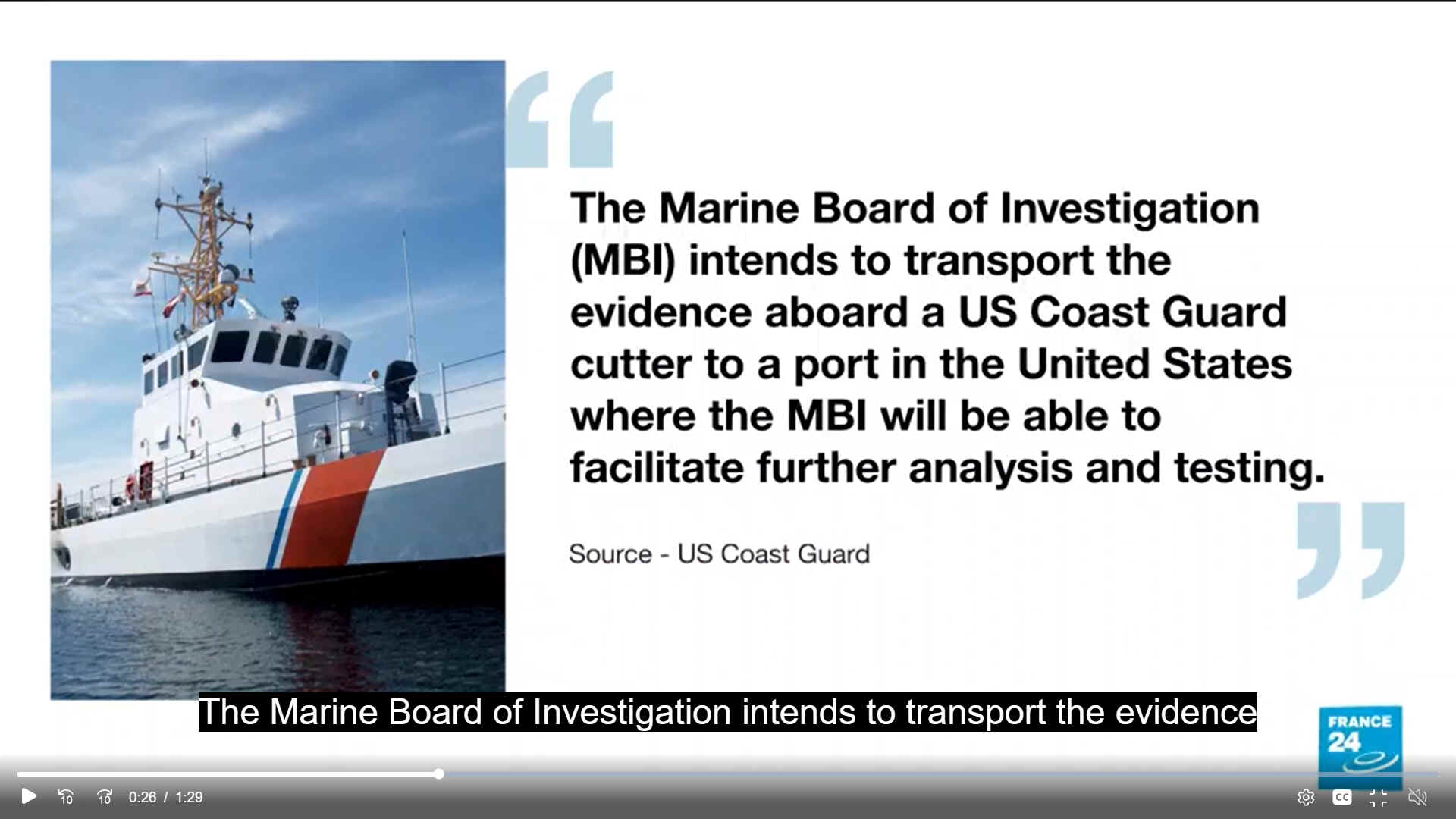
INDY 100 - 24 JUNE 2023 - HOW LONG DID THE TITANIC SUB'S IMPLOSION LAST?
The doomed Titan submarine’s implosion would have happened so fast that the five people onboard who were killed “never knew it happened,” according to an expert.
Tributes have been paid for the men killed on the submersible after search and rescue teams found debris from the OceanGate Expeditions vessel on 22 June.
The victims were Hamish Harding, 58, Shahzada Dawood, 48, and his son Suleman Dawood, 19, Paul-Henri Nargeolet, 77, and Stockton Rush, 61.
US officials said they died in a “catastrophic implosion” sometime after the craft lost contact with the surface one hour and 45 minutes into its dive to the wreck of the Titanic on Sunday.
When communication failed, the vessel would have been a little less than 10,000 feet below the surface, experts told the New York Post, at which point the enormous water pressure would have meant any weakness or crack in the submarine would cause it to instantly implode.
Expert Ofer Ketter said the implosion would have occurred within a millisecond, if not a nanosecond, if something breached the hull of the vessel to cause a loss in pressure.
“They never knew it happened,” he said of the five victims. “Which is actually very positive in this very negative situation.”
“It was instantaneous — before even their brain could even send a type of message to their body that they’re having pain,” Ketter, who is the co-founder of a private submersible company called Sub-Merge.
Pressure that far beneath the water’s surface is around 6,000 pounds per square inch, which the carbon fibre and titanium hull of the Titan was designed to hold.
Dr. Peter Girguis, an oceanographer and Harvard University professor, said: “When a scuba tank is overfilled there’s a safety device that releases gas very quickly. At least that’s the plan.”
“When you take the equivalent of a scuba tank and you want it to hold the pressure out, it’s a different story, because if you go beyond the strength of the vessel then it crushes or collapses.”
He added: “We tend to believe [the implosions] are swift and they tend to be complete, but I want to emphasise again, we don’t exactly know.”
Girguis said submersibles and other such vessels or devices are subjected to pressure tests. They are often required to withstand more pressure than they will likely face to be considered safe.
“So if you’re doing work at a given depth, you have to design it so it can withstand at least 1.5 or two times depending on the nation, the policy, etc,” Giguis said. “We build in those safety factors, then we test it … often up to 10 times.”
The investigation into what caused the sub to implode is ongoing. There is no evidence suggesting OceanGate is at fault, and a conclusion may never be reached.
However, Ketter said implosions “shouldn’t happen, because we know how to build submersibles for them not to implode.
“So, when do implosions happen? To be honest and to be frank, when the engineering is wrong in its calculations.
“When either the structure, the material, the testing, the seals – any other part of the submersible that was designed to go to that depth – was designed wrong and didn’t withstand the pressures that it was designed to.”
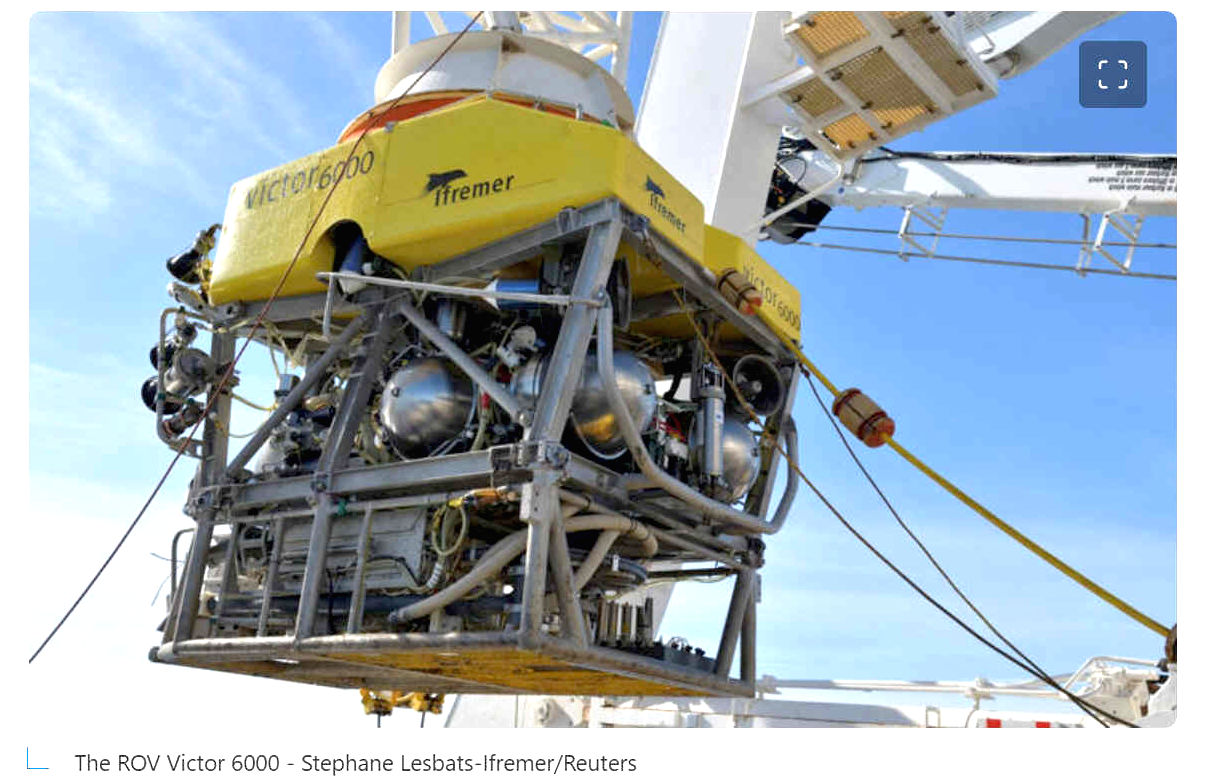
TITAN SUBMERSIBLE SPECIFICATIONS
Maximum depth: 13,123 ft (4,000m)
Capacity: Five people (one pilot and four crew members)
Pressure vessel material: Carbon fibre and titanium
Overall dimensions: 22ft x 9.2ft x 8.3ft high (670cm x 280cm x 250cm)
Weight: 23,000 lbs (10,432 kg)
Speed: 3 knots
Life support: 96 hours for five crew
Authorities raised the alarm on Sunday when the vessel vanished less than two hours into its venture.
The sub had launched its £195,000-a-head ($248,094) tour from the coast of Newfoundland,
Canada, at 2:30am EST (7:30am GMT) on Sunday.
It's understood that Titan communicates with those on the surface by sending an alert to its mothership, the Polar Prince, every 15 minutes.
The five on board last 'pinged' the mothership at 10am EST (3pm GMT) on Sunday, while directly above their destination of the Titanic.
This could indicate that they are now somewhere on the ocean floor, with the wreckage split in two halves at around 12,500ft (3,800m) below the surface.
To put the depth into context, MailOnline has created a graphic showing how this depth compares to famously tall structures, including London's Big Ben, Willis Tower in Chicago and the Grand Canyon.
The Grand Canyon, a natural geological formation in Arizona, is about 6,000 feet (1,828 metres) – less than half the depth of the Titanic's wreckage.
It reveals how landmarks that are famous for their height pale in comparison to this - with the Statue of Liberty at just 305ft (93m), the Eiffel Tower at 1,083ft (330m) and the Empire State Building at 1,250ft (381m).
Even the UAE's Burj Khalifa - the world's tallest building - looks tiny against the depths of the North Atlantic, at a height of 2,217ft (675m).
And the vast Grand Canyon is no different at 6,000ft (1,828m) - less than half the depth of the Titanic's wreckage.
The vessel has been described as a submarine, but it's actually a
submersible.
A submarine is an independent cruiser with its own power supply and air renewal system, while a submersible needs to be supported by a surface vessel or shore team.
On average, submarines can go to around a maximum of 1,476 feet (450 metres), according to Marine Insight, which is just over the height of Chicago's Willis Tower.
But OceanGate's Titan submersible is designed to reach depths nearly 800 per cent greater than this, at a maximum of 13,123 feet (4,000 metres).
While this beats the depth of the North Atlantic seabed, experts fear it may be too far for a US Navy submarine to reach, with its capabilities limited to just 2,000ft (609 metres).
As a result, remotely operated vehicles may be the only alternative to rescue them - reaching maximum depths of 20,000 feet (6,096 metres).
David Gallo, who owns the salvage rights to the Titanic's wreck site, told CNN: 'One of the biggest things is where is it? Is it on the bottom, is it floating, is it mid-water?
'That is something that has not been determined yet... we will have to wait and see and hope for the best.
'The water is very deep - two miles plus. It's like a visit to another
planet, it's not what people think it is. It is a sunless, cold environment and high pressure.'
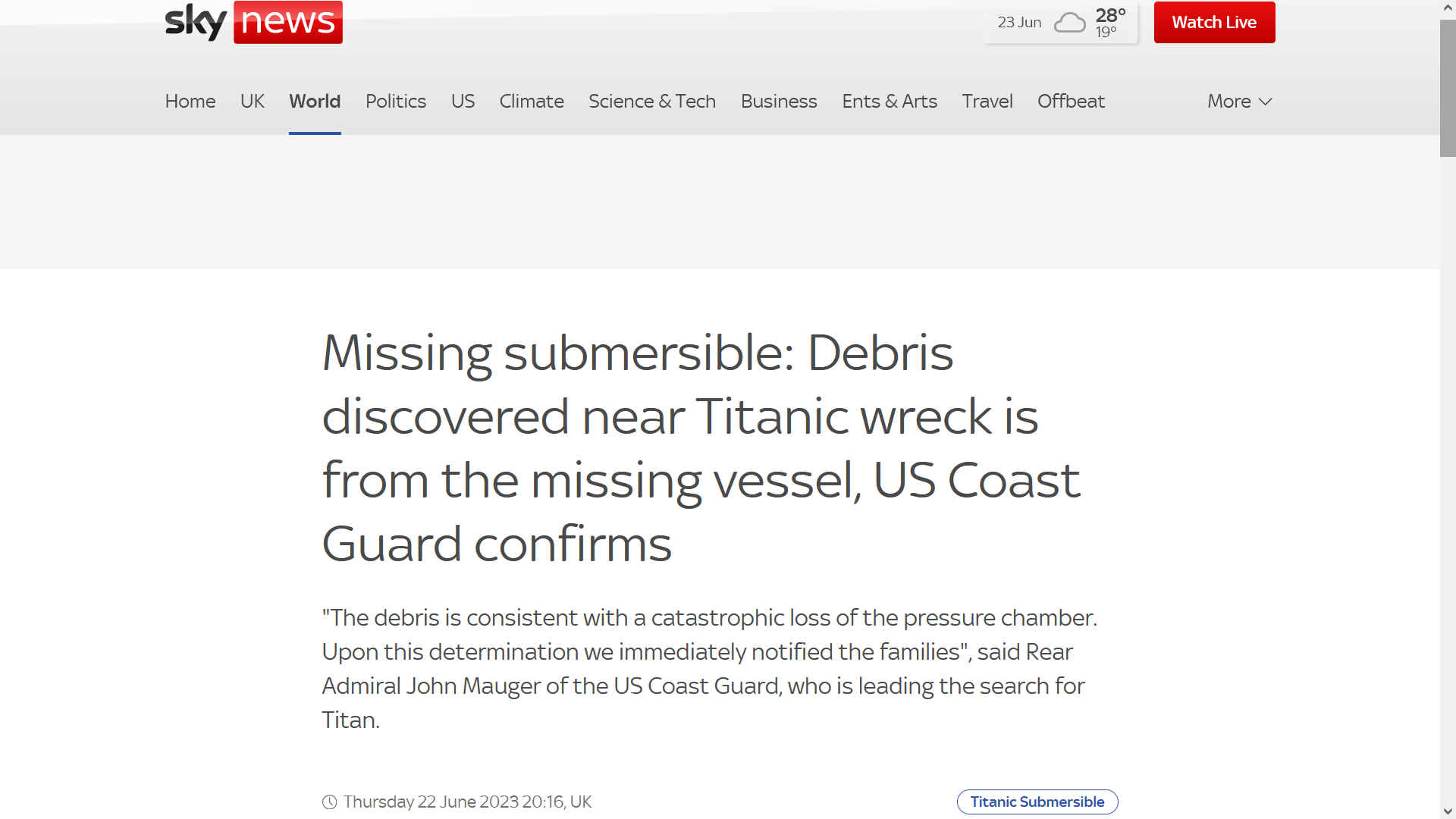
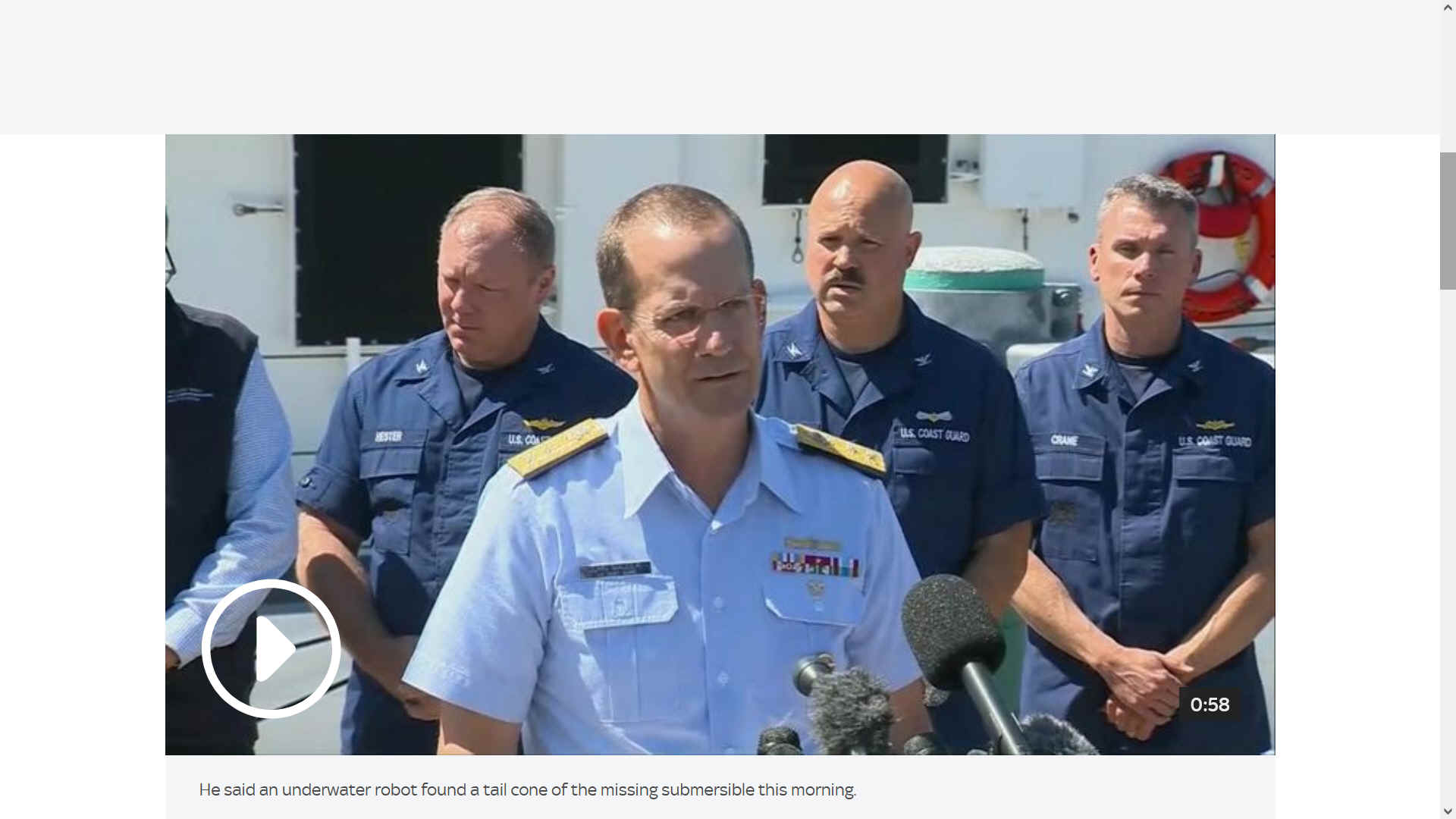
DISASTER IN THE ATLANTIC: HOW MORE THAN 1,500 LOST THEIR
LIVES WHEN THE TITANIC SUNK
The RMS Titanic sank in the North
Atlantic Ocean on April 15, 1912, after colliding with an iceberg during her maiden voyage from Southampton to New York.
More than 1,500 people died when the ship, which was carrying 2,224 passengers and crew, sank under the command of Captain Edward Smith.
Some of the wealthiest people in the world were on board, including property tycoon John Jacob Astor IV, great grandson of John Jacob Astor, founder of the Waldorf Astoria Hotel.
Millionaire Benjamin Guggenheim, heir to his family's mining business, also perished, along with Isidor Straus, the German-born co-owner of Macy's department store, along with his loyal wife Ida.
The ship was the largest afloat at the time and was designed in such a way that it was meant to be 'unsinkable'.
It had an on-board gym, libraries, swimming pool and several restaurants and luxury first class cabins.
There were not enough lifeboats on board for all the passengers due to out-of-date maritime safety regulations.
After leaving Southampton on April 10, 1912, Titanic called at Cherbourg in France and Queenstown in Ireland before heading to New York.
On April 14, 1912, four days into the crossing, she hit an iceberg at 11:40pm ship's time.
James Moody was on night watch when the collision happened and took the call from the watchman, asking him 'What do you see?' The man responded: 'Iceberg, dead ahead.'
By 2.20am, with hundreds of people still on board, the ship plunged beneath the waves, taking many, including Moody, with it.
Despite repeated distress calls being sent out and flares launched from the decks, the first rescue ship, the RMS Carpathia, arrived nearly two hours later, pulling more than 700 people from the water.
It was not until 1985 that the wreck of the ship was discovered in two pieces on the ocean floor.
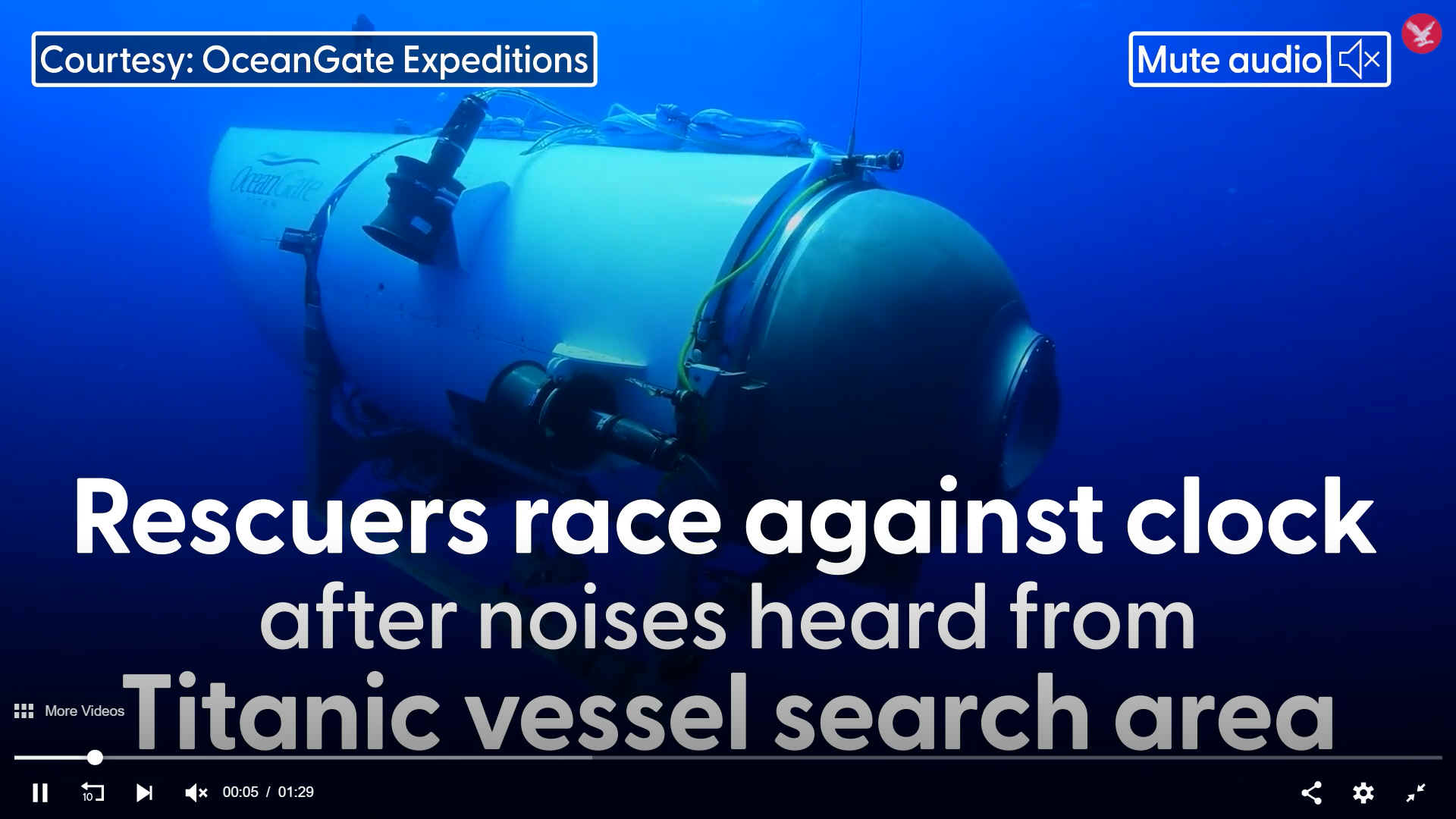
DEEP
SEA EXPEDITION - The sub had launched its £195,000-a-head ($248,094)
£780,000 ($992,376) deep sea tour from the coast of Newfoundland, Canada, at 2:30am EST (7:30am GMT) on Sunday. One of Pakistan's richest men, Shahzada
Dawood, was aboard the vessel alongside his son Suleman, British billionaire Hamish Harding, OceanGate chief executive Stockton Rush and French explorer Paul-Henry
Nargeolet, all confirmed lost on the 22nd June 2023.
Debris found near the Titanic is from the submersible Titan, OceanGate Expeditions confirmed. All five of its passengers are believed to be dead. Tom Maddox, founder of Underwater Forensic Investigators, says where the debris from the submersible is found will tell its own story that could lead to figuring out the point of failure for the expedition.
THE
INDEPENDENT 21ST JUNE 2023
- RADIO SILENCE, ESCAPE OPTIONS AND 'BANGING' SOUNDS - FIVE UNANSWERED QUESTIONS IN THE TITANIC SUB RESCUE
The sudden loss of contact roughly 105 minutes after the Titan departed for the famed wreck site was an ominous sign, experts say.
A deep-sea faring submersible vessel that disappeared on an expedition to the Titanic wreckage site is believed to have less than 12 hours of oxygen left - as rescue crews appear no closer to finding it.
The Titan, a five-person capacity vessel run by OceanGate Expeditions, vanished without a trace about 100 minutes after launching from the Polar Prince icebreaker research ship about 900 miles off the coast of Cape Cod on Sunday morning.
A sweeping search effort involving Canadian Boeing P-8 Poseidon and C-130 Hercules reconnaissance aircraft and underwater sonar buoys has failed to find any sign of the vessel, US Coast Guard Captain Jamie Frederick said in a briefing on Tuesday.
However, the French ship Atalante carrying the Victor 6,000 underwater (ROV) and winch — the only one capable of reaching the Titanic wreck 4,000m under the ocean surface — will have a narrow window of time to conduct potential rescue operations as it is only expected to reach the search site on Wednesday night.
British billionaire explorer Hamish Harding and French diver Paul-Henri Nargeolet — known as Mr Titanic — are onboard, along with Pakistani businessman Shahzada Dawood and his 19-year-old son Sulaiman Dawood.
OceanGate Expeditions confirmed its CEO and founder Stockton Rush was the fifth person aboard on Tuesday.
More than 72 hours after the vessel vanished, many troubling questions remain.
WHY DID THE SUBMERSIBLE GO OFFLINE?
The Titan uses two systems to communicate with its surface ship. Text messages can be sent back and forth, and safety pings are emitted every 15 minutes to indicate the sub’s location and that it is still functioning.
Both systems stopped working about an hour and 45 minutes after the Titan submerged on Sunday morning.
According to its website, OceanGate developed a Real Time Hull Health Monitoring (RTM) safety feature that assesses the integrity of the Titan’s hull throughout every dive.
The technology can likely gauge any weaknesses in the Titan’s carbon fibre hull and transmit the data to its five-person crew and the support ship on the surface.
The hull connects two titanium domes that are specifically built to withstand the extreme pressure from the weight of the
water at 4,000m below sea level.
OceanGate Expeditions revealed earlier this month that Elon
Musk’s Starlink satellite company was providing it with internet connection.
WHAT COULD HAVE HAPPENED TO THE TITAN?
Experts across the industry have offered three potential theories, the most dire being that it imploded under immense pressure. It’s also possible the vessel got trapped in the wreckage, or reached the surface and is lost afloat.
The sudden loss of contact by the Titan’s twin communications systems was an ominous sign, according to longtime tech journalist David Pogue, who travelled to the famous wreck site onboard the Titan in 2022.
“There are only two things that could mean. Either they lost all power or the ship developed a hull breach and it imploded instantly. Both of those are devastatingly hopeless,” Mr Pogue told CBC on Tuesday.
Alistair Greig, a professor of marine engineering at University College London, told the Associated Press that another possibility was a leak in the Titan’s pressure hull.
If the vessel had reached the ocean floor and couldn’t return on its own, “options are very limited,” he said.
“While the submersible might still be intact, if it is beyond the continental shelf, there are very few vessels that can get that deep, and certainly not divers.”
UNDERWATER CURRENTS
Another possibility is the Titan came into contact with the wreckage of the Titanic, and became stuck or had its onboard systems disabled.
The period between entering the water and when it lost contact would roughly correspond to the length of time it would take to reach the wreckage site.
Former ABC News science editor Michael Guillen, who was the first journalist to visit the Titanic wreck site in 2000, shared his own near-death experience after the submersible he was in became caught in an underwater current.
Mr Guillen said a strong ocean rip pushed the vessel towards the Titanic’s 21-tonne propellers, and became wedged under its stern.
The crew of the Mir 1 submersible then frantically tried to reverse out, and appeared to collide with the famous shipwreck.
After 30 minutes of moving backward and forward, the crew eventually managed to free the vessel and return to the surface.
Mr Guillen later wrote in his 2021 memoir 'Believing is Seeing' that he thought he was going to die.
The Canadian military has dropped sonar buoys into the water that would likely be able to detect distress signals made by the five-person crew, if they hadn’t been incapacitated.
WHAT ARE THE BANGING SOUNDS DETECTED?
On Tuesday, bouys detected “tapping sounds” coming from the search area, raising slim hopes that survivors could yet be found.
“We don’t know the source of that noise, but we’ve shared that information with Navy experts to classify it,” US CoastGuard Rear Admiral John Mauger told CBS This Morning.
The sound was detected at 2am local time by a Canadian P-3 aircraft.
It first came every 30 minutes and was heard again four hours later, the internal government memo obtained by CNN states.
Officials admit that the noises are “inconclusive” and are still being analysed by Navy experts.
“With respect to the noises specifically, we don’t know what they are, to be frank with you,” Captain Jamie Frederick of the First Coast Guard District told reporters on Wednesday.
Mr Frederick said that the area of the search was now twice the size of the state of Connecticut on the surface and was being conducted 2.5 miles deep below the Atlantic.
“This is a search and rescue mission, 100 per cent,” Cap Frederick said. “When you’re in the middle of a search and rescue case, you always have hope.”
He added: “Several P3 flights have heard noises yesterday and we relocated assets immediately.
“I think you need to be careful, we need to have hope but I can’t tell you what the noises are but we are searching where the noises are and that’s all we can do at this point.
“My understanding is that the P3 had heard some noises today as well.”
Carl Hartsfield of the Wood Hole Oceanographic Institution told reporters that the noises had been described as “banging” and that they were being analysed by maritime acoustics experts.
He went on to say that there was a large number of vessels now in the area which all give off noises picked up by sensors.
WHAT
EMERGENCY OPTIONS WOULD THE VESSEL HAVE TO FLOAT UP?
The Titan had seven onboard backup systems to return it to the surface. These included “drop weights” of sandbags and lead pipes that would fall off in the event of an emergency and bring the vessel up to the surface using buoyancy.
The Titan was also equipped with an inflatable balloon that was designed to bring it back to the surface. One device is meant to work even if everyone aboard is rendered unconscious.
“If there was a power failure and/or communication failure, this might have happened, and the submersible would then be bobbing about on the surface waiting to be found,” Professor Grieg told the AP.
The US Coast Guard has said it is searching a vast 10,000sqm area, indicating that searchers believe the vessel may have resurfaced somewhere in the North Atlantic.
However, extensive search efforts have so far failed to yield any trace of the Titan.
CAN THE PASSENGERS BE SAVED IN THE VESSEL IS FOUND?
David Concannon, an adviser to OceanGate Expeditions who was supposed to be on the latest expedition, said officials are working to source an unmanned vehicle that could reach the 4,000m depth.
The crushing pressure of the ocean at that extreme depth means that an unmanned vehicle such as a US Navy’s Curv-21 would realistically be the only vessel that could reach the missing submersible.
The Curv-21 can reach a depth of 20,000 feet and relay video, navigation and sonar data back to operators on the ocean surface via its fibre-optic “umbilical cord”, according to the US
Navy.
French president Emmanuel Macron has also sent the research ship Atlante to assist in the search, CNN reported.
The ship is equipped with an underwater robot that can reach depths of 4,000 metres, and is expected to reach the site on Wednesday evening. Crews will have a very short window of time to deploy rescue efforts as
oxygen inside the sub is expected to run out around 7am ET on Thursday.
THE TELEGRAPH 22 JUNE - THE KIT TITANIC SUB RESCUERS ARE PINNING THEIR HOPES ON
Rescuers rushing to find the missing Titan watercraft and the five people on board are pinning their hopes on the technology they have deployed to locate and then extract the submersible from the depths of the sea.
US, Canadian and French rescue teams are already scouring the ocean and British teams have also offered help.
Here is some of the gear and equipment, some at the cutting edge and others dating back to the
Second World
War, being used in a nerve-jangling race against time.
The French-built Victor 6000 is a deepwater ROV that can sink to just under 20,000 feet.
Designed for scientific research, the submersible could dislodge the Titan if it has become stuck in the wreck of the Titanic which its passengers were travelling to observe.
The ROV could also tie a line to the stranded craft so that it can be lifted to the surface by another vessel.
Victor 6000, which has been in service since 1999, is connected to its mother ship by an electromechanical cable which is 26,250ft-long.
Canadian P-3 aircraft are active in the rescue mission and have already detected underwater noises in the search area using sonobuoys dropped into the ocean, which led to rescue operations being refocused.
The P-3 submarine hunter is described by Lockheed Martin, its manufacturer, as “the ultimate maritime patrol aircraft” .
It was used in the Cuban Missile Crisis, Hurricane Katrina and the
BP Horizon oil rig disaster in the US.
The Canadian CP-140 Aurora is based on the Lockheed P-3 Orion, a four-engine aircraft developed in the 1960s with a distinctive tail stinger or “MAD” boom, which is used for magnetic anomaly detection of submarines.
The newer plane was introduced in 1980 and normally has a crew of between 12 to 15.
It has four turboprop engines and four propellers and can travel at up to 455 miles per hour.
The US navy replaced its Lockheed P-3 Orion with this new maritime patrol aircraft from Boeing in 2004.
Designed for anti-submarine warfare and reconnaissance, the 129ft-long P-8 can travel at up to 564mph and carries a crew of two to seven people.
C-130 Hercules aircraft, used normally for troop transport and dating back to 1954, are also trying to detect the submarine from the
air.
The far more modern P-8 can also deploy and monitor sonobuoys.
The search aircraft dropped sonobuoys into the ocean waves, 80 years after they were first used in the
Second World War to detect
Nazi
submarines.
The buoys are now used in search and rescue operations to find missing planes, vessels or submarines and were how the underwater banging noises were first heard.
They are equipped with sonar, a surface float and a radio transmitter for communications with the plane. The sonar emits “pings”, which are meant to echo back off an underwater object.
The object’s location can then be worked out by the echo and is transmitted back to the surface buoy and then the aeroplane.
A 6,400lb remotely operated vehicle or ROV, CURV-21 can plunge to depths of 20,000ft.
Designed to carry out deep-water salvage operations it can travel at a speed of up to 2.5 knots.
The 7ft high and 5ft wide ROV comes equipped with colour television cameras and a high-resolution black and white digital still camera.
It has sonar for target location and pinger detection. It can also be fitted with customised tool packages including salvage equipment.
The ROV will be operated from Deep Energy, a 636ft pipelayer vessel.
Two heavy-duty Hyundai winches with “6,000 kg line pull” written on the side were seen arriving at St John’s airport in Newfoundland. Both winches would need to be used in tandem in order to lift the weight of the Titans.
One of three vessels, which arrived on Wednesday morning to join the search effort, has “side-scanning sonar capabilities”.
The John Cabot has a system used for “detecting and imaging objects on the seafloor”.
The National Oceanic and Atmospheric Administration said side scan sonar had multiple physical sensors called a transducer array.
“As the ship moves along its path, the transducer array sends out signals on both of its sides, sweeping the seafloor like the fan-shaped beam of a flashlight,” it said.
“Side scans search at constant speeds and in straight lines, allowing the ship to map the ocean bottom as it travels.”
Side scan sonar cannot measure depth so it is often used in combination with other tools to map the ocean floor.
The John Cabot arrived to join the search with the Skandi Vinland and Atlantic
Merlin.
This seven-foot-long submersible was among vital rescue equipment flown to Canada by US air force planes to aid the rescue.
The ROV was sent by Pelagic Research Services, a Massachusetts-based company that specialises in deep-sea rescue equipment.
The company said it had been contacted to provide “critical support” to the rescue effort.
Odysseus 6K can dive to a depth of 19,000 feet and weighs less than 3,800 pounds. It is used to install and maintain ocean observation systems, search and recovery and work tasks for industry and exploration.
It is described as a highly portable piece of equipment that can integrate easily with ship systems and is light enough to work from a broad range of boats.
It is controlled remotely from a 20-foot container that has the latest video and data-handling equipment. This control room can be fitted on the deck or interior of a ship.
The Atalante is a French ship, which was diverted from a mission to head to the search area at Emmanuel Macron’s request.
The research vessel is equipped with the Victor 6000 exploration robot and is expected to arrive on Wednesday evening after a request from American authorities.
A team from Ifremer, the French maritime research institute, will join the Atalante to operate the
robot from the ship, which the submersible is connected to by a cable.
Ifremer has worked on previous Titanic dives. The Atalante was built in 1990 and hosts up to 30 technicians and scientists. It is about 277ft long and has an average operating speed of 10 knots.
According to their website, OceanGate Expeditions,
is a company organized under the laws of the Commonwealth of
The Bahamas is a company of undersea explorers, scientists, and filmmakers who are dedicated to manned exploration of the underwater world. Not satisfied with scratching the surface of the ocean near the shoreline, OceanGate Expeditions uses manned submersibles to create expeditions at depths far deeper than can be reached with SCUBA.
ABOUT THE TITAN
Titan is the world’s only carbon-fiber submersible capable of diving five people to 4,000 meters (13,123 feet). It is the submersible they use to survey the wreck of the RMS Titanic during their annual Titanic Expeditions. Titan’s unique ability to carry five people allows for multiple Mission Specialists, scientists and content experts to share a once-in-a-lifetime experience diving in the deep ocean.
The state-of-the-art vessel, designed and engineered by OceanGate Inc. in collaboration with experts from NASA, Boeing and the University of Washington, made its subsea debut in 2018. Through the innovative use of modern materials, Titan is lighter, more spacious, and more comfortable than any other deep-diving submersible exploring the ocean today.
ADVENTURE TOURISTS - TITANIC EXPEDITION - EXPLORE THE TITANIC
The invitation is to follow in Jacques Cousteau’s footsteps and become an underwater explorer — beginning with a dive to the wreck of the RMS Titanic. This is a chance to step outside of everyday life and discover something truly extraordinary.
You could become one of the few to see the Titanic with your own eyes.
Intrepid travelers will sail from the Atlantic coast of Canada for an 8-day expedition to dive on the iconic wreck that lies 380 miles offshore and 3,800 meters below the surface. A dive like this will provide not only a thrilling and unique travel experience, but also help the scientific community learn more about the wreck and the deep ocean environment. Every dive also has a scientific objective and you can learn more about the research the company support.
ITINERARY
DAY 1 - ST. JOHN'S NEWFOUNDLAND, CANADA
Arrive in the seaside city of St. John’s to meet your expedition crew and board the vessel that will take you to the wreck of the RMS Titanic. You’ll familiarize yourself with life on a working vessel as we begin the 400-nautical-mile-journey to the wreck site.
DAY 2 - NORTH ATLANTIC
Welcome to the wild North Atlantic Ocean. As we continue to steam out to the dive site, you’ll learn more about the days ahead and get to know the rest of the expedition crew more. The Expedition Leader will go over important safety information and dive day logistics, and our science team and content experts will help you prepare for what you may discover on your dive. It would be wise to make it an early night – dive days begin bright and early and we may be diving as soon as Day 3.
DAYS 3 - 7 TITANIC DIVE SITE
Depending on the sea state, diving could begin as early as Day 3.
On a dive day, we will begin with final dive checks on the back deck before heading to the bridge for a pre-dive meeting. Then you will climb inside Titan, OceanGate’s five-person submersible, to begin the dive. Those who are not diving the first day will be incorporated into other areas of dive ops — like driving the dingy, assisting the Expedition Manager, collecting media or simply enjoying watching the team work together to do something truly unique.
Once the submersible is launched you will begin to see alienlike lifeforms whizz by the viewport as you sink deeper and deeper into the ocean. The descent takes approximately two hours but it feels like the blink of an eye. You may assist the pilot with coms and tracking, take notes for the science team about what you see outside of the viewport, watch a movie or eat lunch. There is a private toilet at the front of the sub if nature calls.
Soon you will arrive at depth, and after some navigating across the seafloor and debris field, finally see what you’ve been waiting for: the RMS Titanic. The content expert onboard will point out key features, be they of the wreck itself or the life that calls this corner of the ocean home. Enjoy hours of exploring the wreck and debris field before making the two-hour ascent to the surface.
Once on deck, you will be welcomed back by the expedition crew and be able to share the story of your incredible accomplishment.
On the days you’re not diving, you may be part of the dive ops crew for the other dive team, review underwater footage from your dive, chat with experts about the dive’s discoveries, sit in the sun on the top deck, watch a pod of whales swim by the ship, drive a dingy in the wild North Atlantic – non-diving days are just as busy as dive days.
We’ll begin to steam back to St. John’s on Day 7.
DAY 8 - ST. JOHN'S NEWFOUNDLAND, CANADA
Signal Hill is the first thing you’ll see as we motor in to St. John’s. Take a moment to reflect on all that you have accomplished – you’re one of less than 300 people in history who have dove to the world’s most famous shipwreck. You’ll leave the vessel with a collection of media from the dives and an amazing adventure to share when you get back home.
CONTACT OCEANGATE EXPEDITIONS
Tel: +1.425.595.6343
General Inquiries: info@oceangateexpeditions.com
Media Inquiries media@oceangate.com
RMS TITANIC - ARCHAEOLOGY & MARINE ECOLOGY
Since its tragic sinking in 1912, the wreck of the RMS Titanic and its artifacts have rested at 3800 meters on the ocean floor, a harsh environment of corrosive saltwater, extreme pressure, and iron-eating bacteria consuming its hull. These factors have resulted in significant deterioration of parts of the wreck structure.
Our multi-year commitment to studying the wreck on our annual Titanic Expedition will give the scientific and archaeological communities new insight into the wreck’s deterioration and its deep-ocean environment.
MARINE ARCHAEOLOGY AND THE RATE OF TITANIC'S DECAY
Because different metal alloys were used to construct different parts of the ship’s structure, the rate of deterioration varies. Scientists discovered a unique iron-eating bacteria, Halomonas titanicae, that consumes the iron from the wreck and leaves behind colorful “rusticles.” Unlike other shipwrecks, the Titanic is covered in a multitude of colors of rusticles in certain areas.
The bronze telemotor is still intact and free of rusticles. The bridge house that once enclosed the telemotor and the ship’s wheel has completely disappeared. The structure of the officers quarters ranges from total to partial collapse. It’s fascinating to observe the impact this bacteria has on the wreck. These observations will help the scientific community better understand the deep ocean ecosystem.
DEEP OCEAN MARINE BIOLOGY
As the wreck decays, it also serves as an artificial reef in the middle of the abyssal plain of the North Atlantic. The expedition science team will use data collected by prior expeditions, imagery collected from our 2021-2023 Titanic Expeditions, and environmental DNA analysis to develop a more complete picture of the ecology of the site and other natural sites in the same area.
This is important to understanding how and why some communities of organisms develop in geographic isolation while others range broadly across the ocean floor.
SUPPORTING SCIENCE
This important work would not be possible without both our Mission Specialists or OceanGate Foundation. Mission Specialists are people who join us by paying the mission support fee, which helps to underwrite the cost of the Titanic Expedition. Mission Specialists perform a variety of roles like diving the wreck site, gathering data, assisting with surface operations, talking with experts and much more.
OCEANGATE'S SURVEYS OF THE TITANIC WRECK 2021 - 2022
2021 TITANIC EXPEDITION
During the summer of 2021, a multi-disciplinary expedition team conducted the first phase of a multi-year series of crewed submersible dives to explore and document the condition of RMS Titanic and portions of the debris field.
This inaugural phase and series of dives included experts in marine biology, nautical archaeology, marine ecology, and Titanic history. The team succeeded in capturing thousands of images of the bow section, stern section, and portions of the massive debris field. This data is a great resource for assessing changes in the condition of the site and continues to provide a solid foundation for planning future dives and surveys.
2022 TITANIC EXPEDITION
Following the success of the 2021 Titanic Expedition, the expeditionary team returned to the site in the summer of 2022 to continue exploring and documenting the condition of the historic shipwreck and debris field.
Our sponsored science team utilized advanced and time-tested techniques to gather data for future analysis. An array of 4K and 8K cameras, 2D sonar scanners, direct observation and grid mapping are just some of the techniques and equipment that the team utilized during each of the dives that lasted up to 10 hours.
The team also conducted the first-ever Environmental DNA (eDNA) sampling of the site to help determine the presence of species around the wreck by partnering with eDNAtec.
https://www.msn.com/en-gb/news/world/titanic-submarine-s-critical-crack-and-electrical-catastrophe-before-imploding/ar-AA1dc66w
https://www.msn.com/en-gb/news/world/why-are-titan-sub-remains-so-big-experts-weigh-in-as-questions-fly-about-vaporised-wreck/ar-AA1dcABw
https://www.msn.com/en-gb/money/technology/how-long-did-the-titanic-sub-s-implosion-last/ar-AA1cVK2o
https://oceangateexpeditions.com/tour/titanic-expedition/
https://www.msn.com/en-gb/news/world/titanic-submarine-s-critical-crack-and-electrical-catastrophe-before-imploding/ar-AA1dc66w
https://www.msn.com/en-gb/news/world/why-are-titan-sub-remains-so-big-experts-weigh-in-as-questions-fly-about-vaporised-wreck/ar-AA1dcABw
https://www.msn.com/en-gb/money/technology/how-long-did-the-titanic-sub-s-implosion-last/ar-AA1cVK2o
https://oceangateexpeditions.com/tour/titanic-expedition/
ATLANTIS:
THE LOST CITY
OF
BELLARUS
RUSSIAN ALLIES GIVEN BRITISH MOD SOFTWARE SUBMARINE CONTRACT, TELEGRAPH 2024
CHAT
GPT BY OPEN AI - ARTIFICIALLY INTELLIGENT SCRIPT WRITING
MAN Vs MACHINES
CLAYMORE
- NORTH SEA OIL RIG, OCCIDENTAL, ELF AQUITAINE, TALISMAN &
REPSOL
CORONATION
DAY PROTEST ARRESTS, METROPOLITAN POLICE, 6TH MAY 2023,
SKY NEWS
DOUNREAY
- NUCLEAR POWER & MOD TESTING STATION, RADIOACTIVE LEAKS
GOD
SAVE US ALL - FROM THE KING BRITAIN DESERVES, THE GUARDIAN
3RD MY 2023
JUST
STOP OIL - LONDON CLIMATE PROTESTORS 2022-2023, SUELLA
BRAVERMAN DENIAL OF RIGHTS
LIAM
HOLDEN, WATERBOARDING,
BRITISH ARMY GUILTY OF TORTURE, GUARDIAN MARCH 2023
METRO
- LOS
ATLANTES, FOUND SUBMERGED MOUNTAIN VOLCANO LOST CITY ATLANTIS
CSIS SPAIN AUG 2024
NATIONAL
GEOGRAPHIC - 27
MAY 2021 - CROWD CONTROL, PRITI PATEL'S POLICE STATE
NAZI
GERMANY - SPECIAL NAVAL OPERATIONS
NAZI
GOLD - LOST TREASURES, ADOLF HITLER'S $20 BILLION,
BUNKERS, TRAINS, SHIPS, THE SUN 2021
NHS
COVID CONTRACTS - MEDPRO FAST TRACK VIP PAYMENTS MICHELLE
MONE OFFSHORE £29M
NWC
- NATIONAL
WHISTLEBLOWER CENTER, FOSSIL FUEL FRAUD
OPERATION
ATLANTIS - J5 TAX EVASION PROBE, EURO PACIFIC INT. BANKING, PUERTO
RICO
PC
DAVID CARRICK - SERIAL RAPIST, METROPOLITAN POLICE - 16
JANUARY 2023, THE GUARDIAN
PIPER
ALPHA - OCCIDENTAL PETROLEUM CALEDONIA RIG EXPLODED 6 JULY 1988
KILLING 165 MEN
POLAR
JOURNAL - RUSSIAN
NUCLEAR SUBMARINE GRAVEYARD, KARA & NORWEGIAN SEAS
SIZEWELL
- A B & C NUCLEAR POWER STATIONS, SUFFOLK, ENGLAND
THE
GUARDIAN - LOST CITY OF ATLANTIS RISES AGAIN TO FUEL A DANGEROUS MYTH
27-11-22
THE
GUARDIAN - HMS
VANGUARD NUCLEAR REACTOR CORE GLUED BOLT HEADS FEB 2023
THE
GUARDIAN - MET
ARREST JOE BOTH, ON SUSPICION OF CONSPIRACY TO CAUSE PUBLIC
NUISANCE JUNE 2025
TITANIC
- OCEANGATE
EXPLORATIONS MISSING BILLIONAIRE SUBMERSIBLE 21-22 JUNE 2023
WETHERSPOONS
- ASTUTE HUNTER-KILLER TRAINING MANUAL FOUND IN PUB TOILET
APRIL 2023
WGA
STRIKES - WRITERS GUILD OF AMERICA: POOR PAY & USING
AI TO REPLACE PEOPLE MAY 23
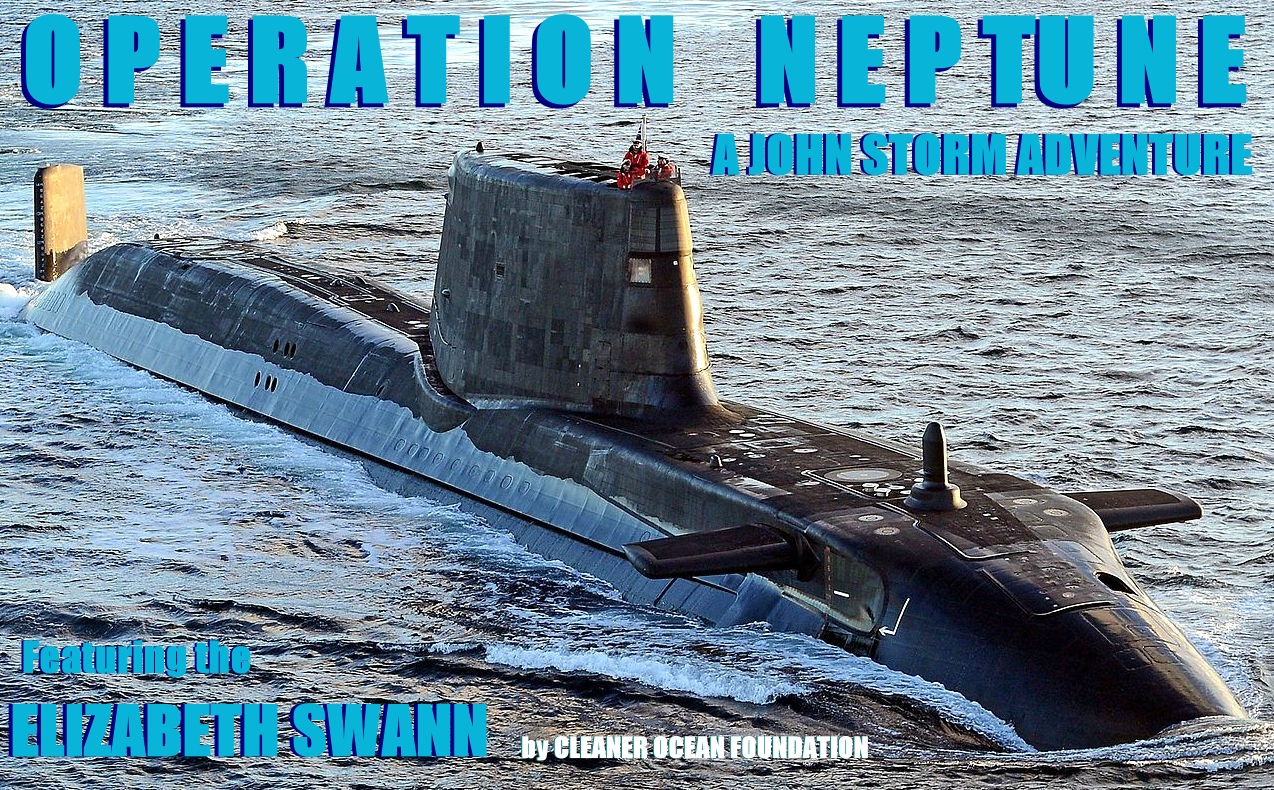
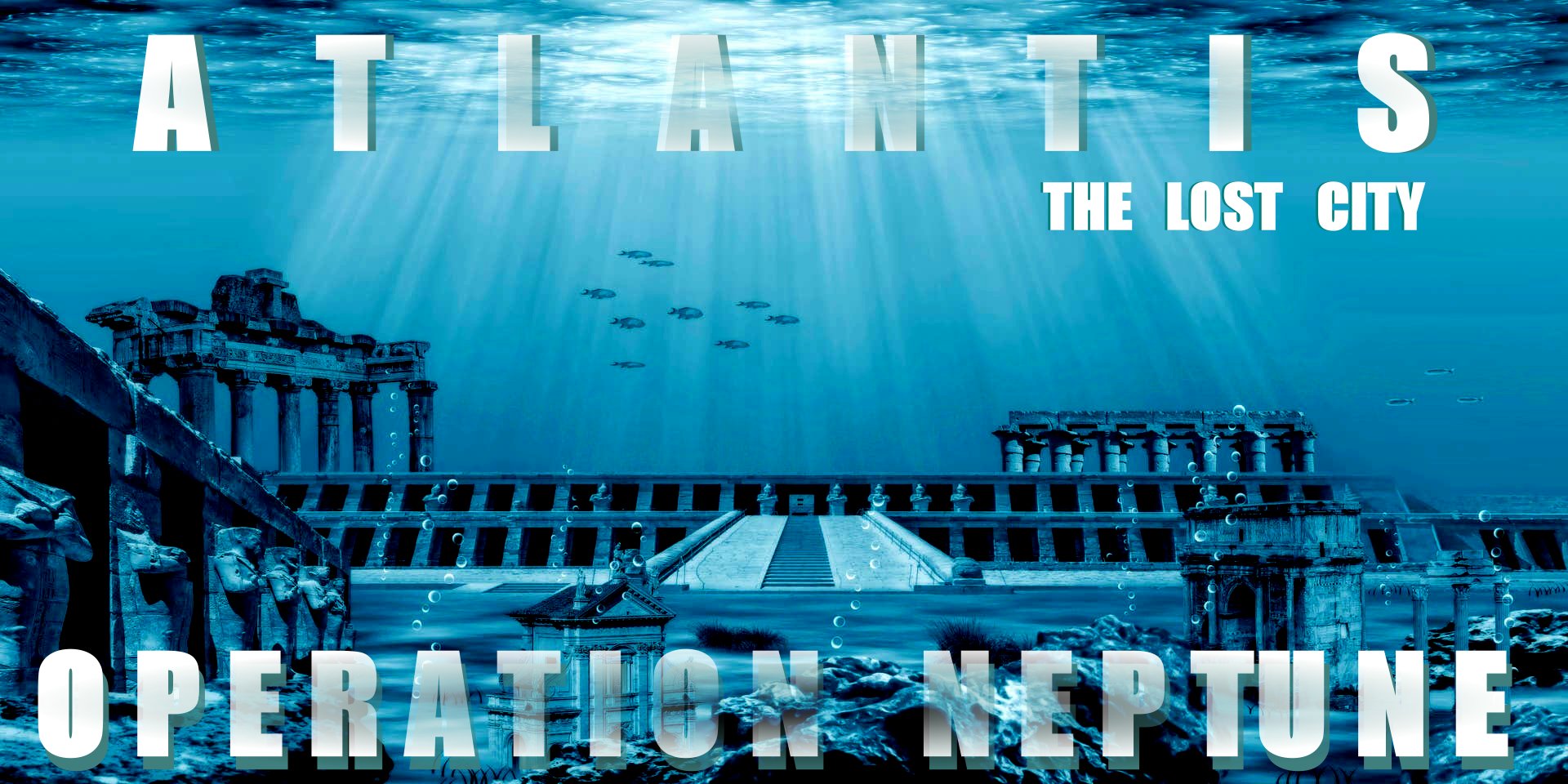
CHARACTERS
|
GOLD |
MEDIA |
MOVIES |
SCREENPLAY |
SUBMARINES
This
website is Copyright © Cleaner
Oceans Foundation Ltd., June 2023. Asserted as per the Berne
Convention.
In
this fictional story, the characters and events are the
product of the author's imagination.
|














